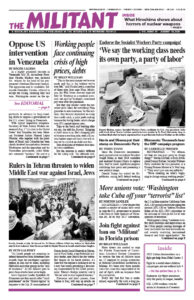“This is the most money we’ve ever made and this is the brokest we’ve ever felt,” said Nicole Lewis, a mother of three who lives near Flint, Michigan, the Wall Street Journal reported July 30. Working as a medical assistant, she and her husband’s combined pay rose after the pandemic.
But they still couldn’t cover the persistent price hikes for everything from groceries to auto insurance. So like millions, they became dependent on using their credit cards, a giant profit-making bonanza for the big banks, which charge over 20% annual interest rates.
Trips to the beach and bowling alley are out, she told the Journal. Shopping at thrift stores is in. She’s changing jobs to become a teaching aide, with a $1-an-hour higher wage and hours that will allow her to cut back on child care fees.
Tens of millions of workers face similar crisis conditions.
But the situation is starkly different for the ruling rich. “An alternate reality is playing out among America’s high earners,” the Journal article, “The Haves and Have-Nots at the Center of America’s Inflation Fight,” said.
“The top whatever-percent has all this money,” Lewis said. “Those people don’t live like most Americans.”
“On top of stocks’ artificial intelligence bonanza, Americans are earning investment income at a seasonally adjusted rate of about $3.7 trillion annually,” the Journal noted, based on the Commerce Department’s June data. As the Militant has been describing for months, there’s a growing class differentiation between working people, who are being battered by high prices for groceries, housing and more, and the capitalist ruling families and their upper-middle-class hangers-on, whose income is soaring.
The Journal describes the life of Joseph Einhorn, who runs a shopping app called Long Story Short. To join costs $1,000 a month. “Einhorn spends his days tracking down products like Rolexes, helicopters and a $36,000 crocodile-skin Gucci trunk” for his clients.
The Biden administration and the Federal Reserve have ballyhooed that their “preferred” inflation gauge, the so-called personal consumption-expenditures index, has eased. They like this gauge because it doesn’t count “volatile” goods, like groceries and rent — number one and two for high prices. As the Journal admits, the drop in the index “doesn’t mean price levels have dropped.”
In the past two years, working people have spent more of their income on food than they have in three decades. These high prices also affect working farmers. Delinquency rates for credit cards are the highest in 14 years.
Jace Lehner, 28, a mother of three, and her husband work on a 2,400-acre family farm 50 miles north of Columbus, Ohio. They grow crops like corn and soybeans while raising cattle and hogs. To reduce grocery purchases, they trade homegrown food such as ground beef or steaks with nearby farmers in exchange for eggs, milk and more. “We’re getting by, but it’s close,” she told the Journal.
Lower prices for corn, soybeans and other agricultural commodities have made it harder for farmers to meet their cost of production. The Department of Agriculture predicts farm income will decline by 25% this year.
Increasing numbers of working people can’t afford high grocery costs and monthly rents. In Brooklyn, New York, 2,500 people line up each week for food distributed free by the Council of Peoples Organization. This is way up from the dozens who did so prior to the 2020 pandemic.
Blocks away “developers built a new apartment in which the smallest unit,” the Journal wrote, a 456-square-foot one bedroom, “was advertised at $460,000.” Overall housing prices are up about 30% since 2021.
Big money private equity investment firms like KKR and Blackstone are buying up apartment complexes to profit off increasing rents. Meanwhile, home prices hit a record high in June, putting moving into a home out of the reach of millions of younger working-class families.
Cheaper “starter homes” today are going for $1 million or more in 237 U.S. cities. Five years ago prices were this high in 84 cities.
Joseph and Melissa Pinto, both special-education teachers, make around $50,000 a year combined and were saving to buy a house. But “it’s hard now to save money to build a down payment when I need to use that money to survive,” Joseph Pinto told the Journal.
High housing costs are making people angry. “It’s gotten out of control, and I blame the people in charge,” said Kayla Lange, a 24-year-old who lives with a roommate in downtown Milwaukee.
Growing numbers of workers are open to looking for something different in politics. Nahona Moore, 28, who also lives in Milwaukee, has voted for Democrats, she told the Journal. But she now blames both Biden and Kamala Harris for “not making anything better.” She said she doesn’t see either the Democrats or Republicans making a difference.
Slowing factory production
With all the Fed’s pompous, self-congratulatory talk about engineering a “soft landing,” there is increasing evidence pointing to a downturn. With slumping sales, John Deere, the world’s largest manufacturer of farm equipment, has cut 2,100 production jobs since November, 15% of its workforce. Rival equipment maker Agco said in June it would eliminate some 800 jobs by the end of the year.
Whirlpool reports a drop in demand for its refrigerators, dishwashers and other household appliances, as does MSC Industrial Direct, a distributor of tools and industrial supplies to manufacturers.
The Labor Department reported unemployment rose in July to 4.3% — its fourth consecutive monthly increase — the highest level since October 2021. Those hardest hit are young workers. The unemployment rate for those in their early 20s rose to 7.4%. For teenagers, it’s up to 12.4%.
New jobs created in July dropped to 114,000, well below the average monthly gain of 215,000 over the previous 12 months. Workers filing for unemployment rose to an 11-month high in the last week in July. Those working part-time hours who want a full-time job rose over the past month by over 340,000, to 4.6 million.

